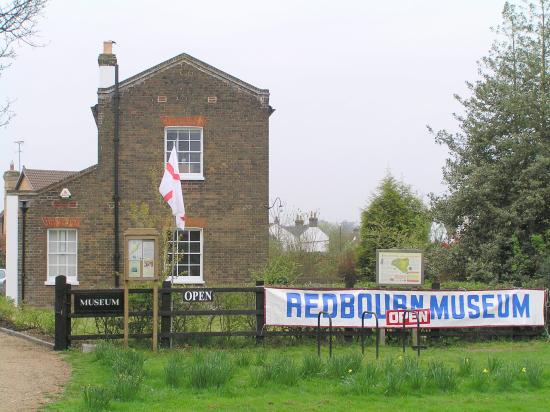


Located on the site of a former steam powered silk mill and later an enormous Brooke Bond tea packing factory, Redbourn Village Museum explores the history of the village of Redbourn. The museum is supported by Redbourn Parish Council and Friends and has been managed and staffed by volunteers since opening in 2000. Its three rooms consider the history, industry and people of Redbourn village through permanent and changing exhibitions and film footage. A selection of local history books and pamphlets are on sale as well as videos and postcards and a Village Trail leaflet. The museum is very attractively sited in the 19th century Silk Mill House overlooking Redbourn Common, next to The Cricketers pub and surrounded by gardens with seating and outdoor exhibits. The garden is used for special events throughout the year.
NO ENTRY CHARGE BUT PLEASE DONATE GENEROUSLY.
OPEN FEBRUARY – NOVEMBER 2017
SATURDAY AND SUNDAY 2 – 5 PM (LAST ADMISSION 4.30 PM)
You will get an extraordinary glimpse of the village throughout its varied history in our galleries, two on the ground floor and one upstairs. There are 2 children’s quizzes and dressing up clothes for under 10s.
The Priory Room opens with 13thC drawings of the martyrdom of St. Alban and his mentor, St. Amphibalus who was put to death on Redbourn Common. As a result, a small priory was founded here and some of the medieval priory stones are on display in this room as well as items from the Stone Age through Roman times to the 19thC. A feature on wells and water pumps includes a rare example of a 16thC tree pump found on the priory site. Overseeing all of this is “Matt the Monk” who is not as scary as he first appears!
In the Occupations Room, is evidence of the amazing wealth of employment that this small village has provided, especially during and after the boom in coaching trade of the 1700s. There are many photographs and exhibits of domestic life. A colourful frieze illustrates some of these trades, creating a bright image of Redbourn’s social history. As well as those working in agriculture, the villagers did straw plaiting and found jobs in the hat factory, silk mill, jam factory and later the Brooke Bond tea packing factory. There are displays on these and also the coaching inns and railway, known locally as The Nickey Line. Find out about Dr Henry Stephens who invented Stephens Blue-Black Ink, practiced medicine in the village and was a friend of poet John Keats.
Museum


Latest Reviews
-
Holly Nielson
23 Jun 2018
3.9




Parking: 3.0
Accessibility: 3.0
Toilets: 3.0
Staff: 5.0
Read All ReviewsRedbourn Museum is run on a shoestring by a dedicated bunch of village people. Redbourn has a lot of history going way back and you’ll find a whole lot of it displayed here. It’s a small building so disability issue will be there as i found but you could easy spend several hours at this museum. A couple of very helpful volunteers showed us around, but they apologised that the upper floor is currently closed due to necessary repairs to one of the walls. Ground floor accesssible with wheelchair. The gardens are absolutely beautiful, with a splendid show of tulips and other bulbs in full flower. The gardener should be congratulated on his work. Overall good visit.